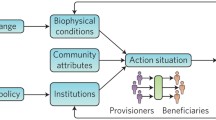Abstract
The European Union took its first strategic step on the topic of climate adaptation in 2009 with publication of a White Paper on Adaptation. Since its publication, many researchers and analysts have criticized the White Paper for its lack of concrete and enforceable actions. In this paper, we analyse the White Paper as an instrument of soft law. First, we provide background on the theory of soft law, its terms of applicability, and the standards by which to judge its success. Second, we analyse the content and context of the White Paper according to soft law principles. We find that the conditions under which the White Paper was adopted were exactly those suited to a soft law approach and highly determined by the European multi-level governance context. As such, the White Paper has managed to achieve several of the common objectives of soft law in particular in setting up processes allowing information-sharing and subsidiarity. However it has failed to achieve several others especially in fostering the commitment of the states, and in moving the European Union in the direction of binding regulation. Further strategy development will be required to fix these deficiencies.
Similar content being viewed by others
References
Berkhout F, Haug C, Rayner T, van Asselt H et al (2010) How do climate policies work? Confronting governance dilemmas in the European union. In: Hulme M, Neufeldt H (eds) Making climate change work for us—European perspectives on adaptation and mitigation strategies. Cambridge, pp 137–164
Chinkin CM (1989) The challenge of soft law: development and change in international law. Int Comp Law Q 38:850–866
Cini M (2000) From soft law to hard law?: discretion and rule-making in the Commission’s state aid regime. European University Institute Working paper, Florence, n. 2000/35
Cram L (1997) Policy-making in the EU. Routledge, London
Dahl A (1999) Competence and subsidiarity perspectives in EU climate change policy: from harmonisation to differentiation? Energ Environ 10(3):XXX
Eckersley R (2004) Soft law, hard politics, and the climate change treaty. In: Reus-Smit C (ed) The politics of international law, Cambridge studies in international relations, 96, Cambridge University Press, pp 80–105
Euractiv (2009) EU mulls climate change adaptation strategy, http://www.euractiv.com/en/climate-change/eu-mulls-climate-change-adaptation-strategy/article-180870
European Commission (1992) Proposal for a council directive introducing a tax on carbon dioxide emissions and energy. COM (92) 226 final
European Commission (2001) White Paper on European Governance, 25 July 2001, COM (2001) 428 final
European Commission (2007) Green Paper on “Adapting to climate change in Europe—options for EU action”, COM(2007) 354 final
European Commission (2009a) White Paper, “Adapting to climate change: towards a European framework for action”, 1 April 2009, COM (2009) 147 final
European Commission (2009b) Commission staff working document on climate change and water, coasts and marine issues, SEC(2009) 386/2
European Commission (2009c) Commission staff working document on human, animal and plant health impacts of climate change, SEC(2009) 416
European Commission (2009d) Commission Staff Working Document on Adapting to climate change: the challenge for European agriculture and rural areas, SEC(2009) 417
European Commission (2009e) Commission staff working document on adapting to climate change _ Impact assessment, SEC(2009) 387
Grosse Ruse-Khan H, Jaeger T, Kordic R (2010) The role of atypical acts in EU external trade and intellectual property policy. Eur J Int Law 21(4):901–939
Klein RJT, Huq S, Denton F, Downing TE, Richels RG, Robinson JB, Toth FL (2007) Inter-relationships between adaptation and mitigation. Climate Change 2007: Impacts, adaptation and vulnerability. In: Parry ML, Canziani OF, Palutikof JP, van der Linden PJ, Hanson CE (eds) Contribution of Working Group II to the Fourth Assessment Report of the Intergovernmental Panel on Climate Change. Cambridge University Press, Cambridge, pp 745–777
Klostermann J, Gupta J, Jong P, Bergsma E (2010)Institutions for climate adaptation: an inventory of institutions in the Netherlands that are relevant for climate change. Report: 19 August 2008–September 2010, Institute for Environmental Studies/WUR-Alterra, Amsterdam
Moravcsik A (1991) Negotiating the single European act: national interests and conventional statecraft in the European community. Int Organ 45(1):19–56
Rayner T, Jordan A (2009) Adaptation to climate change: an emerging EU policy. Paper presented at the 2009 Amsterdam conference on the human dimensions of global environmental change, earth system governance: people, places and the planet. http://www.earthsystemgovernance.org/ac2009/papers/AC2009-0483.pdf
Senden L (2005) Soft law, self-regulation and co-regulation in European Law: where do they meet? Electron J Comp Law 9.1 (January 2005), http://www.ejcl.org/
Skjaerseth JB, Stokke OS, Wettestad J (2006) Soft law, hard law, and effective implementation of international environmental norms. Global Environ Polit 6(3):104–120
Snyder F (1993) Soft Law and Institutional Practice in the European Community, EUI Working Paper LAW n° 93/5
Swart R et al (2009) Europe adapts to climate change. Comparing national adaptation strategies. PEER Report no 1, Helsinki
Thompson A (2011) Efficiency, distribution and the soft law future of the climate regime. Paper presented at International Policymakig and Agreements Conference, Yale University, 8–9 April 2011
Trubek DM, Cottrell P, Nance M (2005) Soft law, “hard law” and European integration: Toward a Theory of Hybridity, University of Wisconsin Legal Studies Research Paper No. 1002
World Wildlife Fund (2009) WWF’s statement on the EU Commission communication on “adapting to climate change”, http://wwf.panda.org/what_we_do/how_we_work/policy/wwf_europe_environment/news/?161141/WWFs-statement-on-the-EU-Commission-communication-on-adapting-to-climate-change
Acknowledgments
Funding for this research came from the Mediation project, coordinated by the University of Wageningen, of the European Commission’s Seventh Framework Programme for research and cooperation. We would like to thank our colleagues Stefan Pfenninger and Susanne Hanger for valuable support and comments. All remaining errors of fact or interpretation are those of the authors.
Author information
Authors and Affiliations
Corresponding author
Rights and permissions
About this article
Cite this article
Dreyfus, M., Patt, A. The European Commission White Paper on adaptation: appraising its strategic success as an instrument of soft law. Mitig Adapt Strateg Glob Change 17, 849–863 (2012). https://doi.org/10.1007/s11027-011-9348-0
Received:
Accepted:
Published:
Issue Date:
DOI: https://doi.org/10.1007/s11027-011-9348-0




